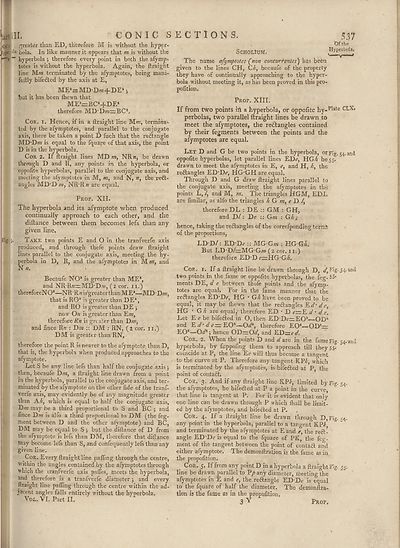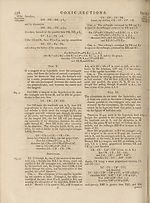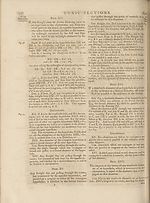Encyclopaedia Britannica, or, a Dictionary of arts, sciences, and miscellaneous literature : enlarged and improved. Illustrated with nearly six hundred engravings > Volume 6, CHI-Crystallization
(567) Page 537
Download files
Complete book:
Individual page:
Thumbnail gallery: Grid view | List view

1'J ill. CONIC S
Oft greater than ED, therefore M is without the hyp^r-
bola. In like manner it appears that m is without the
““"V " hyperbola •, therefore every point in both the afymp-
totes is without the hyperbola. Again, the ftraight
line terminated by the afymptotes, being mani-
feilly bifecled by the axis at E,
ME’rtMD-D/n+DES
but it has been {hewn that
ME’^BC’+DE*
therefore MD'Dw—BC*.
Cor. i. Hence, if in a flraight line Mw, termina¬
ted by the afymptotes, and parallel to the conjugate
axis, there be taken a point D fuch that the reftangle
MD‘D/« is equal to the fquare of that axis, the point
D is in the hyperbola.
Cor 2. If ftraight lines MD NR«, be drawn
through D and R, any points in the hyperbola, or
oppofite hyperbolas, parallel to the conjugate axis, and
meeting the afymptotes in M, w, and N, », the rect¬
angles MD'D ///, NR‘R« are equal.
Prop. XII.
The hyperbola and its afymptote when produced
continually approach to each other, and the
diftance between them becomes lefs than any
given line.
Fig.p Take two points E and O in the tranfverfe axis
produced, and through thefe points draw ftraight
lines parallel to the conjugate axis, meeting the hy¬
perbola in D, R, and the afymptotes in M»/, and
N«.
Becaufe NO* is greater than ME*,
and NR R«—PvID-Dw, (2 cor. n.)
thereforeNO*—NR Rwis’greaterthanME*—MD'Dw,
that is RO* is greater than DE*,
and RO is greater than DE j
now Ofl is greater than Eot,
therefore Rn is greater than Dw,
and lines R« : Dm :: DM : RN, (2 cor. n.)
DM is greater than RN,
therefore the point R is nearer to the afymptote than D,
that is, the hyperbola when produced approaches to the
afymptote.
Let S be any line lefs than half the conjugate axis j
then, becaufe Dm, a ftraight line drawn from a point
in the hyperbola, parallel to the conjugate axis, and ter¬
minated by the afymptote on the other fide of the tranf¬
verfe axis, may evidently be of any magnitude greater
than A//, which is equal to half the conjugate axis,
Dm may be a third proportional to S and BC ; and
fince D^ is alfo a third proportional to DM (the feg-
ment between D and the other afymptote) and BC,
DM may be equal to S j but the diftance of D from
the afymptote is lefs than DM, therefore that diftance
inay become lefs than S, and confequently lefs than any
given line.
Cor. Every ftraight line pafllng through the centre,
V'ithin the angles contained by the afymptotes through
vhich the tranfverfe axis palfes, meets the hyperbola,
and therefore is a tranfverfe diameter; and every
ftraight line palling through the centre within the ad¬
jacent angles falls entirely without the hyperbola.
Vol. VI. Part II.
E C T I O N S. 537
Of the
SCHOLIUM. Hyperbola.
The name afijmptotes (non concuri'entes') has been
given to the lines CH, C//, becaufe of the property
they have of continually approaching to the hyper¬
bola without meeting it, as has been proved in this pro-
pofition.
Prop. XIII.
If from two points ill a hyperbola, or oppofite hy-PIate
perbolas, two parallel ftraight lines be drawn to
meet the afymptotes, the re&angles contained
by their fegments between the points and the
afymptotes are equal.
Let D and G be two points in the hyperbola, orpig. 54. and
oppofite hyperbolas, let parallel lines EDe, HG^ be 55.
drawn to meet the afymptotes in E, e, and H, h, the
rectangles ED'De, HG'GH are equal.
Through D and G draw ftraight lines parallel to
the conjugate axis, meeting the afymptotes in the
points L, /, and M, m. The triangles HGM, EDL
are fimilar, as alfo the triangles h G m, e D /,
therefore DL : DE :: GM : GH,
and D/: De :: Gm : Gh;
hence, taking the rectangles of the correfponding termi
of the proportions,
LD D/: EDT> :: MG Gw : llG Gh.
But LDvD/—MG-G/« (2 cor. 11.)
therefore ED’D erzHG'G^.
Cor. 1. If a ftraight line be drawn through D, ^ Fig. 54. and
two points in the fame or oppofite hyperbolas, the leg- 55*
ments DE, d e between thofe points and the afymp¬
totes are equah For in the fame manner that the
reftangles ED’Df, HG • Gh have been proved to be
equal, it may be Ihewn that the rectangles Y^d' dc,
HG * Gh are equal, therefore ED • D E d ' d e.
Let E e be bifefted in O, then ED'D^—EO*—OD*
and YLd-de — YLO''—Ck/% therefore EO*—OD*=r
EO*—(V*j hence ODrrCV, and YLD-zzed.
Cor. 2. When the points D and d are in the fame Fig. 54. and
hyperbola, by fuppofing them to approach till they 55°
coincide at P, the line Ee will thus become a tangent
to the curve at P. Therefore any tangent KP/*, which
is terminated by the afymptotes, is bifefted at P, the
point of contaft.
Cor. 3. And if any ftraight line KP£, limited by Fig. 54,
the afymptotes, be bifefted at P a point in the curve,
that line is tangent at P. For it is evident that only
one line can be drawn through P which lhall be limit¬
ed by the afymptotes, and bife&ed at P.
Cor. 4. If a ftraight line be drawn through D, Fig. 54.
any point in the hyperbola, parallel to a tangent KP^
and terminated by the afymptotes at E and e, the reft-
angle ED'Dt- is equal to the fquare of PK, the fcg-
ment of the tangent between the point of contaft and
either afymptote. The demonftration is the fame as in
the propofition.
# Cor. 5. If from any point D in a hyperbola a ftraight Fig. 55.
line be drawn parallel to P/> any diameter, meeting the
afymptotes in E and e, the re&angle ED-Dt- is equal
to the fquate of half the diameter. The demonftra¬
tion is the fame as in the propofition,
3 Y
Prop.
Oft greater than ED, therefore M is without the hyp^r-
bola. In like manner it appears that m is without the
““"V " hyperbola •, therefore every point in both the afymp-
totes is without the hyperbola. Again, the ftraight
line terminated by the afymptotes, being mani-
feilly bifecled by the axis at E,
ME’rtMD-D/n+DES
but it has been {hewn that
ME’^BC’+DE*
therefore MD'Dw—BC*.
Cor. i. Hence, if in a flraight line Mw, termina¬
ted by the afymptotes, and parallel to the conjugate
axis, there be taken a point D fuch that the reftangle
MD‘D/« is equal to the fquare of that axis, the point
D is in the hyperbola.
Cor 2. If ftraight lines MD NR«, be drawn
through D and R, any points in the hyperbola, or
oppofite hyperbolas, parallel to the conjugate axis, and
meeting the afymptotes in M, w, and N, », the rect¬
angles MD'D ///, NR‘R« are equal.
Prop. XII.
The hyperbola and its afymptote when produced
continually approach to each other, and the
diftance between them becomes lefs than any
given line.
Fig.p Take two points E and O in the tranfverfe axis
produced, and through thefe points draw ftraight
lines parallel to the conjugate axis, meeting the hy¬
perbola in D, R, and the afymptotes in M»/, and
N«.
Becaufe NO* is greater than ME*,
and NR R«—PvID-Dw, (2 cor. n.)
thereforeNO*—NR Rwis’greaterthanME*—MD'Dw,
that is RO* is greater than DE*,
and RO is greater than DE j
now Ofl is greater than Eot,
therefore Rn is greater than Dw,
and lines R« : Dm :: DM : RN, (2 cor. n.)
DM is greater than RN,
therefore the point R is nearer to the afymptote than D,
that is, the hyperbola when produced approaches to the
afymptote.
Let S be any line lefs than half the conjugate axis j
then, becaufe Dm, a ftraight line drawn from a point
in the hyperbola, parallel to the conjugate axis, and ter¬
minated by the afymptote on the other fide of the tranf¬
verfe axis, may evidently be of any magnitude greater
than A//, which is equal to half the conjugate axis,
Dm may be a third proportional to S and BC ; and
fince D^ is alfo a third proportional to DM (the feg-
ment between D and the other afymptote) and BC,
DM may be equal to S j but the diftance of D from
the afymptote is lefs than DM, therefore that diftance
inay become lefs than S, and confequently lefs than any
given line.
Cor. Every ftraight line pafllng through the centre,
V'ithin the angles contained by the afymptotes through
vhich the tranfverfe axis palfes, meets the hyperbola,
and therefore is a tranfverfe diameter; and every
ftraight line palling through the centre within the ad¬
jacent angles falls entirely without the hyperbola.
Vol. VI. Part II.
E C T I O N S. 537
Of the
SCHOLIUM. Hyperbola.
The name afijmptotes (non concuri'entes') has been
given to the lines CH, C//, becaufe of the property
they have of continually approaching to the hyper¬
bola without meeting it, as has been proved in this pro-
pofition.
Prop. XIII.
If from two points ill a hyperbola, or oppofite hy-PIate
perbolas, two parallel ftraight lines be drawn to
meet the afymptotes, the re&angles contained
by their fegments between the points and the
afymptotes are equal.
Let D and G be two points in the hyperbola, orpig. 54. and
oppofite hyperbolas, let parallel lines EDe, HG^ be 55.
drawn to meet the afymptotes in E, e, and H, h, the
rectangles ED'De, HG'GH are equal.
Through D and G draw ftraight lines parallel to
the conjugate axis, meeting the afymptotes in the
points L, /, and M, m. The triangles HGM, EDL
are fimilar, as alfo the triangles h G m, e D /,
therefore DL : DE :: GM : GH,
and D/: De :: Gm : Gh;
hence, taking the rectangles of the correfponding termi
of the proportions,
LD D/: EDT> :: MG Gw : llG Gh.
But LDvD/—MG-G/« (2 cor. 11.)
therefore ED’D erzHG'G^.
Cor. 1. If a ftraight line be drawn through D, ^ Fig. 54. and
two points in the fame or oppofite hyperbolas, the leg- 55*
ments DE, d e between thofe points and the afymp¬
totes are equah For in the fame manner that the
reftangles ED’Df, HG • Gh have been proved to be
equal, it may be Ihewn that the rectangles Y^d' dc,
HG * Gh are equal, therefore ED • D E d ' d e.
Let E e be bifefted in O, then ED'D^—EO*—OD*
and YLd-de — YLO''—Ck/% therefore EO*—OD*=r
EO*—(V*j hence ODrrCV, and YLD-zzed.
Cor. 2. When the points D and d are in the fame Fig. 54. and
hyperbola, by fuppofing them to approach till they 55°
coincide at P, the line Ee will thus become a tangent
to the curve at P. Therefore any tangent KP/*, which
is terminated by the afymptotes, is bifefted at P, the
point of contaft.
Cor. 3. And if any ftraight line KP£, limited by Fig. 54,
the afymptotes, be bifefted at P a point in the curve,
that line is tangent at P. For it is evident that only
one line can be drawn through P which lhall be limit¬
ed by the afymptotes, and bife&ed at P.
Cor. 4. If a ftraight line be drawn through D, Fig. 54.
any point in the hyperbola, parallel to a tangent KP^
and terminated by the afymptotes at E and e, the reft-
angle ED'Dt- is equal to the fquare of PK, the fcg-
ment of the tangent between the point of contaft and
either afymptote. The demonftration is the fame as in
the propofition.
# Cor. 5. If from any point D in a hyperbola a ftraight Fig. 55.
line be drawn parallel to P/> any diameter, meeting the
afymptotes in E and e, the re&angle ED-Dt- is equal
to the fquate of half the diameter. The demonftra¬
tion is the fame as in the propofition,
3 Y
Prop.
Set display mode to:
![]() Universal Viewer |
Universal Viewer | ![]() Mirador |
Large image | Transcription
Mirador |
Large image | Transcription
Images and transcriptions on this page, including medium image downloads, may be used under the Creative Commons Attribution 4.0 International Licence unless otherwise stated. ![]()
| Permanent URL | https://digital.nls.uk/193014794 |
|---|
| Attribution and copyright: |
|
|---|
| Description | Ten editions of 'Encyclopaedia Britannica', issued from 1768-1903, in 231 volumes. Originally issued in 100 weekly parts (3 volumes) between 1768 and 1771 by publishers: Colin Macfarquhar and Andrew Bell (Edinburgh); editor: William Smellie: engraver: Andrew Bell. Expanded editions in the 19th century featured more volumes and contributions from leading experts in their fields. Managed and published in Edinburgh up to the 9th edition (25 volumes, from 1875-1889); the 10th edition (1902-1903) re-issued the 9th edition, with 11 supplementary volumes. |
|---|---|
| Additional NLS resources: |
|

